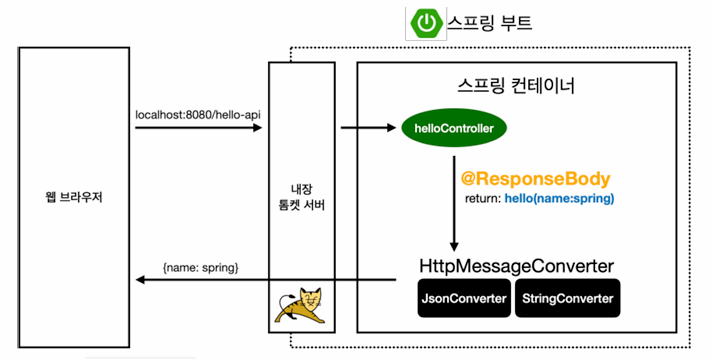[Spring] 김영한 스프링 입문 정리 #2 스프링 웹 개발 기초
1. 스프링 웹 개발 방법
웹을 개발하는 3가지 방법이 존재한다.
| 개발 방법 | 설명 |
|---|---|
| 정적 콘텐츠 | - HTML, CSS, JavaScript 파일과 같은 고정된 컨텐츠를 제공하는 방식이다. (이전 포스팅의 Welcome Page와 같음) - 서버에서 파일을 클라이언트에게 그대로 전달하며, 데이터나 페이지 내용이 변경되지 않는 경우에 주로 사용한다. 간단히 파일을 그대로 내려주는 방식 |
| MVC와 템플릿 엔진 | 서버에서 프로그래밍을 통해 HTML을 동적으로 바꿔서 내려주는 것을 말한다. 그렇게 하기위해 MVC(Model-View-Controller) 방식의 패턴으로 개발하는 경우가 많다. - Model: 데이터와 비즈니스 로직을 처리 - View: 사용자에게 데이터를 표시하는 역할 - Controller: 사용자 입력을 처리하고 모델과 뷰를 업데이트 즉, 템플릿 엔진은 미리 정의된 템플릿 파일과 데이터 소스를 결합하여 HTML, XML, 또는 다른 문서 형식을 생성한다. |
| API | XML이나 JSON과 같은 데이터 구조 포맷으로 클라이언트에 데이터를 전달하는 방식을 말한다. (서버끼리 통신할 때 등) |
2. 정적 컨텐츠
2.1 정적 컨텐츠 제공
스프링 부트 정적 컨텐츠 기능은 [여기↗] 에서 자세히 확인할 수 있다.
기본 설정으로 스프링 부트는 정적 폴더를 /static에서 제공한다.
resources/static/hello-static.html을 만들어보자.
그 후, 아래 코드를 실행하고 http://localhost:8080/hello-static.html로 접속하기!
<!DOCTYPE html>
<html>
<head>
<title>static content</title>
<meta http-equiv="Content-Type" content="text/html; charset=UTF-8" />
</head>
<body>
정적 컨텐츠 입니다.
</body>
</html>
즉, 정적 컨텐츠는 서버에서 파일을 클라이언트에게 그대로 전달하는 것을 볼 수 있다.

2.2 정적 컨텐츠 동작 방식

① URL 요청
사용자가 웹 브라우저에서 http://localhost:8080/hello-static.html로 접속한다.
② 내장 톰캣 서버 처리
스프링 부트는 내장된 톰캣 서버를 사용하므로, 해당 URL 요청은 톰캣 서버로 전달된다.
③ 컨트롤러 우선 처리
스프링 부트는 요청을 먼저 컨트롤러에서 찾는다.
하지만 hello-static.html을 처리할 수 있는 컨트롤러가 없다면, 해당 요청을 처리할 수 없다고 판단한다.
④ 정적 리소스 처리
컨트롤러에서 해당 요청을 처리할 수 없을 때, 스프링 부트는 resources/static/ hello.static.html 파일을 찾아 반환한다.
즉, static 폴더에 있는 정적 HTML 파일을 자동으로 제공하게 된다.
⑤ 브라우저에 반환
스프링 부트는 hello-static.html 파일을 웹 브라우저에 반환하여 사용자가 HTML 내용을 볼 수 있도록 한다.
3. MVC와 템플릿 엔진📌
3.1 MVC란?
MVC는 Model, View, Controller가 분리 되어있는 방법이다.
- 관심사 분리를 위해 View는 화면을 그리는데 집중, Model와 Controller는 비즈니스 로직과 관련되어 있도록 한다.
- 모델(Model): 데이터와 로직 처리
- 뷰(View): 사용자에게 보여주는 화면
- 컨트롤러(Controller): 사용자의 입력을 처리하고 모델과 뷰를 연결
3.2 Controller
controller/HelloController
package hello.hello_project.controller;
import org.springframework.stereotype.Controller;
import org.springframework.ui.Model;
import org.springframework.web.bind.annotation.GetMapping;
import org.springframework.web.bind.annotation.RequestParam;
@Controller
public class HelloController {
// 정적 콘텐츠 방식
@GetMapping("hello")
public String hello(Model model){
model.addAttribute("data","hello!!!");
return "hello";
}
// MVC 방식
@GetMapping("hello-mvc")
// 윈도우 파라미터 옵션 단축키(Ctrl + p)
public String helloMvc(@RequestParam(name = "name") String name, Model model){
// 파라미터로 들어온 name을 넘겨줌
model.addAttribute("name",name);
return "hello-template";
}
}

3.3 View
resources/templates/hello-template.html
타임리프(thymeleaf)는 뷰 템플릿 엔진으로 컨트롤러가 전달하는 데이터를 이용하여 동적으로 화면을 구성할 수 있게 해준다.
<html xmlns:th="http://www.thymeleaf.org">
<body>
/* $표시 : modle 키 값 name으로 치환*/
<p th:text="'hello ' + ${name}">hello! empty</p>
</body>
</html>

3.4 MVC 동작 방식

① 웹 브라우저 요청
사용자가 http://localhost:8080/hello-mvc?name=Spring 로 요청을 보낸다.
② 내장 톰캣 서버
요청을 받으면, 내장 톰캣 서버는 이를 스프링 부트 애플리케이션에 전달한다.
③ 컨트롤러 처리
스프링 부트는 HelloController 클래스에서 @GetMapping("hello-mvc")와 매핑된 메서드를 호출한다.
이때, name=Spring이라는 요청 파라미터를 모델(Model)로 넘겨준다. (model.addAttribute("name", name))
④ 뷰 템플릿 렌더링
컨트롤러는 “hello-template”이라는 뷰 이름을 리턴한다.
스프링은 이 이름에 맞는 템플릿 파일을 찾기 위해 resources/templates/hello-template.html을 검색한다.
⑤ 템플릿 엔진 처리
타임리프(Thymeleaf) 템플릿 엔진이 HTML 파일을 렌더링한다.
템플릿 내에서 ${name}은 모델에 담긴 "name" 키를 참조하여 "Spring"으로 치환한다.
⑥ 결과 반환
변환된 HTML 파일이 웹 브라우저로 반환되어 사용자에게 보여진다.
4. API
정적 컨텐츠를 제외하면 사실 두 가지로 볼 수 있다.
- 서버에서 View를 찾아서 템플릿 엔진을 통해 화면을 렌더링해서 html을 웹브라우저에 내려주는 방법이 있고 (= MVC와 템플릿 엔진),
- 데이터를 (일반적으로 JSON 형태로) 바로 내리는 방법이 있다. (= API)
@ResponseBody에 문자를 반환하는 예시
@Controller
public class HelloController {
// API 방식
@GetMapping("hello-string")
@ResponseBody
public String helloString(@RequestParam("name") String name){
return "hello " + name;
}
}
- @ResponseBody는 뷰 리졸버(viewResolver) 를 사용하지 않고, HTTP 응답 본문(body)에 데이터를 직접 반환한다.
- 이를 통해 템플릿 엔진을 사용하지 않고, 요청에 대한 응답을 동적으로 생성하여 클라이언트에게 전달할 수 있다.
- 이 방식은 주로 RESTful API에서 JSON, XML, 텍스트 등을 반환할 때 사용된다.
http://localhost:8080/hello-string?name=String!!!로 실행
API는 문자가 그대로 출력되는 것을 확인할 수 있다.

- 사용자가 http://localhost:8080/hello-string?name=Spring!!! 와 같은 요청을 보내면,
name=Spring!!!이라는 파라미터가 helloString 메서드로 전달된다. - helloString 메서드는 @ResponseBody 어노테이션을 사용하여 반환 값을 HTTP 응답 본문에 담아 클라이언트로 전달한다.
- 이 때, 템플릿 엔진은 사용되지 않으며, 단순히 문자열이 그대로 응답으로 반환된다.
@ResponseBody가 객체를 반환하는 예시 -> 데이터 전달하고 싶을 때 사용
package hello.hello_project.controller;
import org.springframework.stereotype.Controller;
import org.springframework.ui.Model;
import org.springframework.web.bind.annotation.GetMapping;
import org.springframework.web.bind.annotation.RequestParam;
import org.springframework.web.bind.annotation.ResponseBody;
@Controller
public class HelloController {
// 문자를 반환
@GetMapping("hello-string")
@ResponseBody
public String helloString(@RequestParam("name") String name){
return "hello " + name;
}
// 객체를 반환
@GetMapping("hello-api")
@ResponseBody
public Hello helloApi(@RequestParam("name") String name){
Hello hello = new Hello();
hello.setName(name);
return hello;
}
// static class를 만들면 class 안에서 class를 생성할 수 있다.
static class Hello{
private String name;
public String getName(){
return name;
}
public void setName(String name){
this.name = name;
}
}
}
@ResponseBody 를 사용하고, 객체를 반환하면 객체가 JSON으로 변환된다.
http://localhost:8080/hello-api?name=spring로 실행

@ResponseBody 사용 원리

- 스프링은 이전과 같이 hello-api라는 Controller를 찾는다.
- 이때 Controller에 @ResponseBody 태그가 붙어있으면 MVC 방식에서의 viewResolver가 아닌 HttpMessageConverter가 동작한다.
- Controller에서 반환하는 값이 string이라면 StringHttpMessageConverter가 작동하여 string을 바로 처리하고,
- 객체가 반환되면 MappingJackson2HttpMessageConverter가 작동해 객체를 JSON방식으로 변환한다.
- JSON으로 만들어진 객체는 바로 웹 브라우저에 key-value 쌍으로 반환된다.
getter, setter란?
- getter와 setter는 클래스의 필드(변수)에 대한 접근을 제어하기 위해 사용되는 메서드이다. -> 객체 지향 프로그래밍 캡슐화 가능
- 단축키(windows)⭐: (Alt+Insert)에 들어가 Getter and Setter 클릭
| 메서드 | 설명 |
|---|---|
| Getter | 클래스의 필드 값을 반환하는 메서드 |
| Setter | 클래스의 필드 값을 설정하는 메서드 |
getter, setter 예제
public class Person {
private String name;
private int age;
// Getter for name
public String getName() {
return name;
}
// Setter for name
public void setName(String name) {
this.name = name;
}
// Getter for age
public int getAge() {
return age;
}
// Setter for age
public void setAge(int age) {
this.age = age;
}
}

댓글남기기